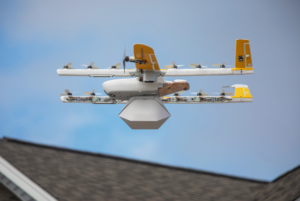
In the ever-evolving world of drone technology, the demand for longer flight times, greater payload capacities, and environmentally sustainable solutions has never been higher. Airober, a leader in innovative drone technology, has responded to these challenges with its cutting-edge Hydrogen Energy Management System (EMS). But what exactly is Hydrogen EMS, how does it work, and why is it a game-changer for the industry? Let’s dive into the science behind this revolutionary technology.
Understanding Hydrogen Fuel Cells
At the heart of Airober’s Hydrogen EMS is the hydrogen fuel cell, a device that converts chemical energy from hydrogen into electrical energy through a chemical reaction with oxygen. Unlike conventional batteries, which store energy chemically and release it through electrochemical reactions, hydrogen fuel cells generate electricity by combining hydrogen gas with oxygen, producing water and heat as byproducts.
Here’s a simplified breakdown of how a hydrogen fuel cell works:
- Hydrogen Supply: Hydrogen gas (H₂) is supplied to the anode side of the fuel cell.
- Electrochemical Reaction: At the anode, hydrogen molecules are split into protons (H⁺) and electrons (e⁻) by a catalyst. The protons pass through a membrane to the cathode, while the electrons create an electric current that can be harnessed to power the drone.
- Water Formation: At the cathode, the protons, electrons, and oxygen from the air combine to form water (H₂O), which is expelled as a harmless byproduct.
The Role of Hydrogen EMS in Drones
Airober’s Hydrogen EMS is an advanced system that integrates hydrogen fuel cells into drone technology, optimizing the power output and managing the energy flow to ensure maximum efficiency. The EMS controls the entire energy conversion process, from hydrogen intake to electricity generation, ensuring that the drone’s power demands are met consistently and reliably.
Key Components of Airober’s Hydrogen EMS:
- Hydrogen Storage: The EMS includes specialized tanks designed to safely store hydrogen gas at high pressure, allowing for extended flight times without increasing the drone’s weight significantly.
- Fuel Cell Stack: The fuel cells are arranged in stacks to produce the necessary voltage and power output. Airober’s system is designed to be scalable, meaning the number of cells can be adjusted based on the drone’s size and intended use.
- Power Management System: The EMS continuously monitors the drone’s power consumption and adjusts the fuel cell output accordingly. This ensures optimal performance, whether the drone is cruising or carrying out power-intensive maneuvers.
- Cooling System: As fuel cells generate heat during operation, the EMS includes a cooling mechanism to maintain optimal operating temperatures, preventing overheating and ensuring the longevity of the cells.

Why Airober’s Hydrogen EMS Matters
The introduction of Hydrogen EMS by Airober is more than just an incremental improvement in drone technology; it represents a fundamental shift towards a more sustainable, efficient, and powerful energy solution. Here’s why it matters:
1. Extended Flight Time
One of the most significant advantages of hydrogen fuel cells over traditional lithium-ion batteries is their superior energy density. This means drones equipped with Airober’s Hydrogen EMS can fly for much longer periods, covering greater distances and completing more tasks in a single flight. This is particularly crucial for applications such as aerial surveying, search and rescue operations, and logistics, where endurance is key.
2. Environmental Impact
Hydrogen fuel cells are a zero-emission technology. The only byproduct of the electricity generation process is water vapor, making Airober’s Hydrogen EMS an environmentally friendly alternative to fossil fuel-powered drones. In a world increasingly focused on reducing carbon footprints, this technology positions Airober at the forefront of green innovation.
3. Scalability and Versatility
Airober’s Hydrogen EMS is designed to be versatile, catering to a wide range of drone sizes and applications. Whether it’s a small drone for precision agriculture or a larger model for cargo delivery, the EMS can be scaled and adapted to meet the specific energy needs, making it a flexible solution for various industries.
4. Reliability and Safety
Safety is a top priority in any aerial operation. Hydrogen EMS is engineered with multiple safety features, including pressure regulation, leak detection, and automated shutdown systems in case of emergencies. These features ensure that the technology is not only powerful but also reliable and safe to use.
The Future of Drone Technology
As the demand for high-performance drones continues to grow, so too will the need for advanced energy solutions. Airober’s Hydrogen EMS is poised to lead the way, offering a glimpse into the future of drone technology where extended flight times, increased payload capacities, and environmental sustainability are the new standards.
By embracing hydrogen fuel cells, Airober is not just enhancing the capabilities of drones today but also paving the way for the broader adoption of hydrogen as a key energy source in various industries. As hydrogen infrastructure expands and the cost of fuel cells decreases, the potential for Airober’s Hydrogen EMS to revolutionize not only drones but also other forms of transportation and energy storage is immense.
Conclusion
The science behind Airober’s Hydrogen EMS is a testament to the power of innovation in overcoming the limitations of traditional energy sources. By harnessing the clean, efficient, and powerful potential of hydrogen fuel cells, Airober is setting new benchmarks for drone performance and sustainability. As industries across the globe continue to adopt drone technology, Airober’s Hydrogen EMS will undoubtedly play a crucial role in shaping the future of aviation.

Leave a Reply